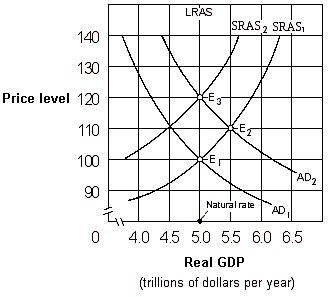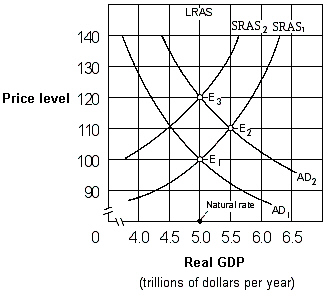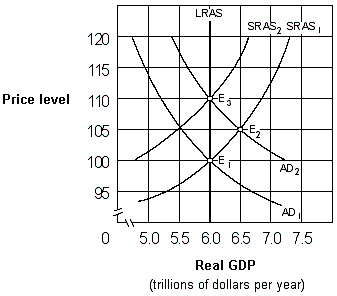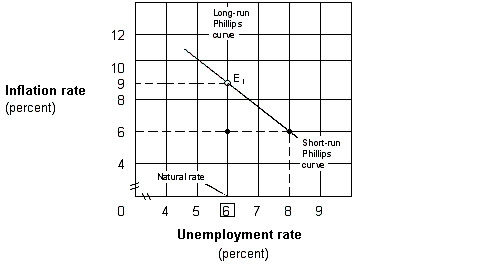Correct Answer

verified
Correct Answer
verified
Multiple Choice
The rational expectations hypothesis implies that discretionary macro-policy will:
A) be ineffective, even in the short run.
B) be effective in the short run but ineffective in the long run.
C) be effective both in the short run and long run.
D) make it possible to trade-off a higher rate of inflation for a lower rate of unemployment.
Correct Answer

verified
Correct Answer
verified
Multiple Choice
According to the Phillips curve, a more expansionary macro-policy that causes inflation to be greater will:
A) place downward pressure on prices.
B) reduce unemployment.
C) reduce output.
D) reduce the natural rate of unemployment.
Correct Answer

verified
Correct Answer
verified
Multiple Choice
Under the natural rate hypothesis, expansionary monetary and fiscal policies can at best produce a:
A) permanent change in the unemployment rate.
B) short-run change in the unemployment rate.
C) permanent change in the inflation rate.
D) short-run change in the long-run Phillips curve.
Correct Answer

verified
Correct Answer
verified
Multiple Choice
Exhibit 17-3 Aggregate demand and aggregate supply curves  As shown in Exhibit 17-3, if people behave according to adaptive expectations theory, an increase in the aggregate demand curve from AD1 to AD2 will cause the price level to move:
As shown in Exhibit 17-3, if people behave according to adaptive expectations theory, an increase in the aggregate demand curve from AD1 to AD2 will cause the price level to move:
A) from 100 to 110 initially and then eventually move back to 100.
B) directly from 100 to 110 and then remain at 110.
C) directly from 100 to 120 and then remain at 120.
D) from 100 to 110 initially and then eventually move to 120.
Correct Answer

verified
Correct Answer
verified
Multiple Choice
Exhibit 17-3 Aggregate demand and aggregate supply curves  As shown in Exhibit 17-3, if people behave according to adaptive expectations theory, an increase in the aggregate demand curve from AD1 to AD2 will cause the economy to move:
As shown in Exhibit 17-3, if people behave according to adaptive expectations theory, an increase in the aggregate demand curve from AD1 to AD2 will cause the economy to move:
A) from E1 to E2 initially and then eventually move back to E1.
B) directly from E1 to E2 and then remain at E2.
C) directly from E1 to E3 and then remain at E3.
D) from E1 to E2 initially and then eventually move to E3.
Correct Answer

verified
Correct Answer
verified
Multiple Choice
Exhibit 17-2 Aggregate demand and aggregate supply curves  As shown in Exhibit 17-2, if people behave according to rational expectations theory, an increase in the aggregate demand curve from AD1 to AD2 will cause:
As shown in Exhibit 17-2, if people behave according to rational expectations theory, an increase in the aggregate demand curve from AD1 to AD2 will cause:
A) labor to adjust nominal wages sluggishly.
B) the aggregate supply curve to remain at SRAS1.
C) the price level to eventually rise from 100 to 110.
D) none of these.
Correct Answer

verified
Correct Answer
verified
Multiple Choice
Under the adaptive expectations hypothesis, which of the following is the effect of a shift to a more expansionary monetary policy?
A) In the short run, the real rate of output will be unaffected, but in the long run, it will increase.
B) In the short run, the unemployment rate will decrease, but in the long run, it will self correct to the natural rate of unemployment.
C) There will be a permanent increase in the real rate of output, but the inflation rate will also be a little higher.
D) In the short run, the impact on the real rate of output is uncertain, but in the long run, output will increase.
Correct Answer

verified
Correct Answer
verified
Multiple Choice
The proponents of adaptive expectations believe that:
A) there will be a substantial time lag before people anticipate the effects of a shift to a more expansionary macro-policy.
B) macro-policies that stimulate demand and place upward pressure on the general level of prices will temporarily increase output and employment.
C) discretionary changes in macro-policy can be made in a manner that will reduce the economic ups and downs of a market economy.
D) all of these are true.
Correct Answer

verified
Correct Answer
verified
Multiple Choice
Which of the following models emphasizes the importance of credible, predictable government policies for maintaining full employment with low inflation?
A) The monetarist model.
B) The Keynesian model.
C) The supply-side model.
D) The rational expectations model.
Correct Answer

verified
Correct Answer
verified
Multiple Choice
Exhibit 17-5 Short-run and long-run Phillips curve  Suppose the government shown in Exhibit 17-5 uses contractionary monetary policy to reduce inflation from 9 to 6 percent. If people have rational expectations, then:
Suppose the government shown in Exhibit 17-5 uses contractionary monetary policy to reduce inflation from 9 to 6 percent. If people have rational expectations, then:
A) the economy will remain stuck at point E1.
B) the natural rate will permanently increase to 8 percent.
C) unemployment will rise to 8 percent in the short run.
D) unemployment will remain at 6 percent as the inflation rate falls.
Correct Answer

verified
Correct Answer
verified
Multiple Choice
Suppose that the economy experiences an increase in the inflation rate at the same time that the unemployment rate decreases. This situation indicates a:
A) shift in the Phillips curve.
B) movement along a vertical Phillips curve.
C) movement along a horizontal Phillips curve.
D) movement along a positively-sloped Phillips curve.
E) movement along a negatively-sloped Phillips curve.
Correct Answer

verified
Correct Answer
verified
Multiple Choice
Under adaptive expectations, the short-term effect of an unanticipated shift to a more expansionary macroeconomic policy will be a:
A) temporary reduction in the unemployment rate.
B) permanent reduction in the unemployment rate.
C) temporary reduction in the inflation rate.
D) permanent reduction in the inflation rate.
Correct Answer

verified
Correct Answer
verified
Multiple Choice
Under the natural rate hypothesis, expansionary monetary and fiscal policies can at best produce a:
A) permanent change in the long-run Phillips curve.
B) short-run change in the unemployment rate.
C) long-run change in the unemployment rate.
D) permanent change in the unemployment rate.
Correct Answer

verified
Correct Answer
verified
Multiple Choice
Since the 1970s, the Phillips curve has:
A) remained stable.
B) moved in a clockwise direction.
C) been unstable.
D) been used as a reliable model to guide public policy.
Correct Answer

verified
Correct Answer
verified
Multiple Choice
According to the theory of rational expectations,
A) workers' experience tells them that government action to lower unemployment will not affect inflation.
B) consumers and investors generally behave so that rationally formed government attempts to stimulate aggregate demand have their desired effects.
C) policy goals can be achieved easily in the short run.
D) workers' wage demands include anticipated inflation.
E) expansionary monetary policy will lead to permanent interest rate declines.
Correct Answer

verified
Correct Answer
verified
Multiple Choice
On a Phillips curve diagram, an increase in the rate of inflation, other things being equal, is represented by a(n) :
A) upward movement along the Phillips curve.
B) downward movement along the Phillips curve.
C) upward shift of the Phillips curve.
D) downward shift of the Phillips curve.
Correct Answer

verified
Correct Answer
verified
Multiple Choice
On a Phillips curve diagram, a decrease in the rate of inflation, other things being equal, is represented by a(n) :
A) upward movement along the Phillips curve.
B) downward movement along the Phillips curve.
C) upward shift of the Phillips curve.
D) downward shift of the Phillips curve.
Correct Answer

verified
Correct Answer
verified
Multiple Choice
The Phillips curve illustrates the relationship between:
A) change in the money supply and change in unemployment.
B) tax rates and tax revenues.
C) the equilibrium level of income and the employment rate.
D) inflation and unemployment.
Correct Answer

verified
Correct Answer
verified
Multiple Choice
Which of the following best describes the idea of a political business cycle?
A) Politicians have a bias to cut taxes and increase government spending.
B) Special interests result in alternating federal deficits.
C) Politicians will use fiscal and monetary policy to cause output, real incomes, and employment to be rising prior to elections.
D) Good intentions of politicians influence the business cycle.
Correct Answer

verified
Correct Answer
verified
Showing 81 - 100 of 120
Related Exams